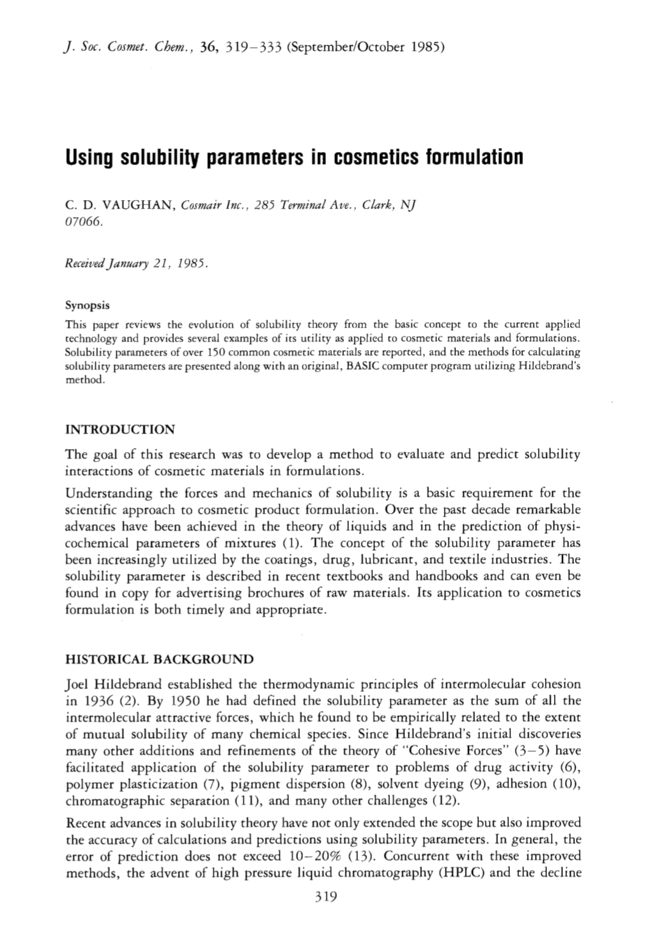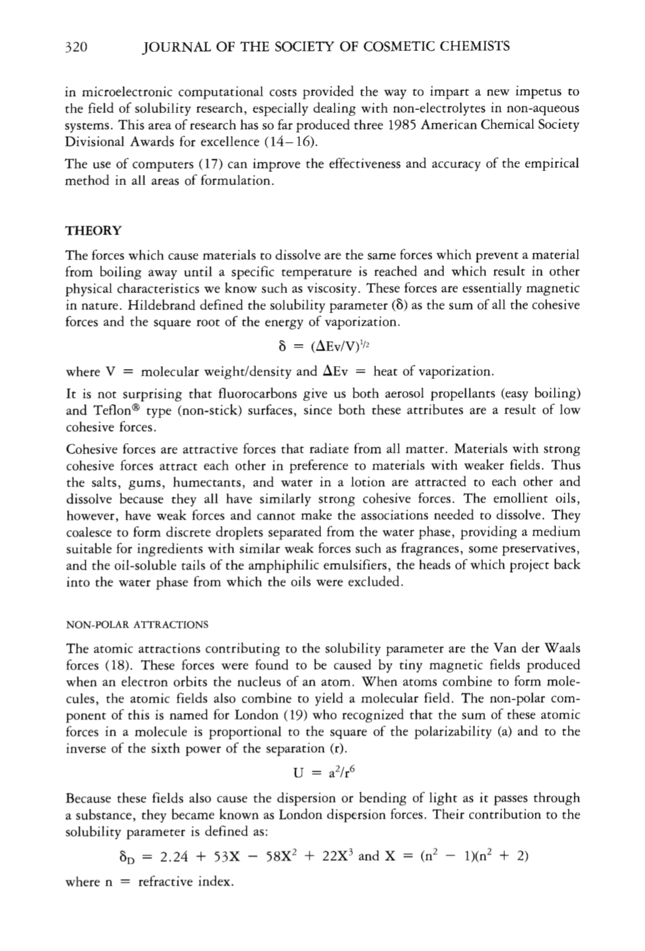j. Soc. Cosmet. Chem., 36, 319-333 (September/October 1985) Using solubility parameters in cosmetics formulation C. D. VAUGHAN, Cosmair Inc., 285 Terminal Ave., Clark, NJ 07066. Received January 21, 1985. Synopsis This paper reviews the evolution of solubility theory from the basic concept to the current applied technology and provides several examples of its utility as applied to cosmetic materials and formulations. Solubility parameters of over 150 common cosmetic materials are reported, and the methods for calculating solubility parameters are presented along with an original, BASIC computer program utilizing Hildebrand's method. INTRODUCTION The goal of this research was to develop a method to evaluate and predict solubility interactions of cosmetic materials in formulations. Understanding the forces and mechanics of solubility is a basic requirement for the scientific approach to cosmetic product formulation. Over the past decade remarkable advances have been achieved in the theory of liquids and in the prediction of physi- cochemical parameters of mixtures (1). The concept of the solubility parameter has been increasingly utilized by the coatings, drug, lubricant, and textile industries. The solubility parameter is described in recent textbooks and handbooks and can even be found in copy for advertising brochures of raw materials. Its application to cosmetics formulation is both timely and appropriate. HISTORICAL BACKGROUND Joel Hildebrand established the thermodynamic principles of intermolecular cohesion in 1936 (2). By 1950 he had defined the solubility parameter as the sum of all the intermolecular attractive forces, which he found to be empirically related to the extent of mutual solubility of many chemical species. Since Hildebrand's initial discoveries many other additions and refinements of the theory of "Cohesive Forces" (3-5) have facilitated application of the solubility parameter to problems of drug activity (6), polymer plasticization (7), pigment dispersion (8), solvent dyeing (9), adhesion (10), chromatographic separation (11), and many other challenges (12). Recent advances in solubility theory have not only extended the scope but also improved the accuracy of calculations and predictions using solubility parameters. In general, the error of prediction does not exceed 10-20% (13). Concurrent with these improved methods, the advent of high pressure liquid chromatography (HPLC) and the decline 319
320 JOURNAL OF THE SOCIETY OF COSMETIC CHEMISTS in microelectronic computational costs provided the way to impart a new impetus to the field of solubility research, especially dealing with non-electrolytes in non-aqueous systems. This area of research has so far produced three 1985 American Chemical Society Divisional Awards for excellence (14-16). The use of computers (17) can improve the effectiveness and accuracy of the empirical method in all areas of formulation. THEORY The forces which cause materials to dissolve are the same forces which prevent a material from boiling away until a specific temperature is reached and which result in other physical characteristics we know such as viscosity. These forces are essentially magnetic in nature. Hildebrand defined the solubility parameter (8) as the sum of all the cohesive forces and the square root of the energy of vaporization. 8 = (AEv/V)V2 where V = molecular weight/density and AEv = heat of vaporization. It is not surprising that fluorocarbons give us both aerosol propellants (easy boiling) and Teflon © type (non-stick) surfaces, since both these attributes are a result of low cohesive forces. Cohesive forces are attractive forces that radiate from all matter. Materials with strong cohesive forces attract each other in preference to materials with weaker fields. Thus the salts, gums, humectants, and water in a lotion are attracted to each other and dissolve because they all have similarly strong cohesive forces. The emollient oils, however, have weak forces and cannot make the associations needed to dissolve. They coalesce to form discrete droplets separated from the water phase, providing a medium suitable for ingredients with similar weak forces such as fragrances, some preservatives, and the oil-soluble tails of the amphiphilic emulsifiers, the heads of which project back into the water phase from which the oils were excluded. NON-POLAR ATTRACTIONS The atomic attractions contributing to the solubility parameter are the Van der Waals forces (18). These forces were found to be caused by tiny magnetic fields produced when an electron orbits the nucleus of an atom. When atoms combine to form mole- cules, the atomic fields also combine to yield a molecular field. The non-polar com- ponent of this is named for London (19) who recognized that the sum of these atomic forces in a molecule is proportional to the square of the polarizability (a) and to the inverse of the sixth power of the separation (r). U = a2/r 6 Because these fields also cause the dispersion or bending of light as it passes through a substance, they became known as London dispersion forces. Their contribution to the solubility parameter is defined as: 8r) = 2.24 + 53X - 58X 2 + 22X 3 and X = (n 2 - 1)(n 2 + 2) where n = refractive index.
Purchased for the exclusive use of nofirst nolast (unknown) From: SCC Media Library & Resource Center (library.scconline.org)





























































